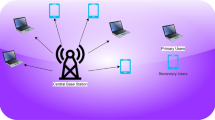Abstract
This paper introduces PARO, a dynamic power controlled routing scheme that helps to minimize the transmission power needed to forward packets between wireless devices in ad hoc networks. Using PARO, one or more intermediate nodes called “redirectors” elects to forward packets on behalf of source–destination pairs thus reducing the aggregate transmission power consumed by wireless devices. PARO is applicable to a number of networking environments including wireless sensor networks, home networks and mobile ad hoc networks. In this paper, we present the detailed design of PARO and evaluate the protocol using simulation and experimentation. We show through simulation that PARO is capable of outperforming traditional broadcast-based routing protocols (e.g., MANET routing protocols) due to its energy conserving point-to-point on-demand design. We discuss our experiences from an implementation of the protocol in an experimental wireless testbed using off-the-shelf radio technology. We also evaluate the impact of dynamic power controlled routing on traditional network performance metrics such as end-to-end delay and throughput.
Similar content being viewed by others
References
S. Agarwal, S.V. Krishnamurthy, R.H. Katz and S. Dao, Distributed power control in ad hoc wireless networks, in: Proceedings of PIMRC, San Diego, CA (2001).
I. Ali, R. Gupta, S. Bansal, A. Misra, A. Razdan and R. Shorey, Energy efficiency and throughput for TCP traffic in multi-hop wireless networks, in: Proceedings of InfoCom, New York, NY (2002).
L. Bononi, M. Conty and L. Donatiello, PS-DCC: A distributed contention control mechanism leading to the power saving optimality in random access wireless local area networks, Technical Report (1999).
J.-H. Chang and L. Tassiulas, Energy conserving routing in wireless ad-hoc networks, in: Proceedings of IEEE InfoCom, Tel-Aviv, Israel (2000).
D. Goodman and N. Mandayam, Power control for wireless data, in: Proceedings of IEEE International Workshop on Mobile Multimedia Communications (MOMUC) (1999).
P. Gupta and P.R. Kumar, The capacity of wireelss networks, IEEE Transactions on Information Theory 46(2) (2000).
W.R. Heinzelman, A. Chandrakasan and H. Balakrishnan, Energy efficient rouing protocols for wireless microsensors networks, in: Proceedings of Hawaii International Conference on System and Sciences, Hawaii (January 2000).
http://www.bluetooth.com
http://www.homerf.org
IEEE Vehicular Technology Society Committee on Radio Propagation, Coverage prediction for mobile radio systems operating in the 800/900 MHz frequency range 914 MHz, IEEE Transactions on Vehicular Technology 37(1) (1988).
IETF Mobile Ad-Hoc Network Working Group (MANET), http:// www.ietf.org/html.charters/manet-charter.html
D.B. Johnson and D.A. Maltz, The dynamic source routing protocol for mobile ad hoc networks, draft-ietf-manet-dsr-02.txt (1999), work in progress.
T.J. Kwon and M. Gerla, Clustering with power control, in: Proceedings of IEEE MILCOM, Atlantic City, NJ (November 1999).
J. Li et al., Capacity of ad hoc wireless networks, in: Proceedings of ACM MobiCom (July 2002).
J. Monks, V. Bharghavan and W. Hwu, A Power Controlled Multiple Access Protocol (PCMAP) for wireless packet networks, in: Proceedings of InfoCom, Anchorage, AK (April 2001).
S. Narayanaswamy, V. Kawadia, R.S. Sreenivas and P.R. Kumar, Power control in ad-hoc networks: theory, architecture, algorithm and implementation of the COMPOW protocol, in: Proceedings of European Wireless 2002, Florence, Italy (February 2002).
C.E. Perkins and P. Bhagwat, Highly dynamic Destination-Sequenced Distance-Vector routing (DSDV) for mobile computers, Proceedings of ACM SigComm 24(4) (1994).
C.E. Perkins, E.M. Royer and S.R. Das, Ad hoc On-demand Distance Vector (AODV) routing, draft-ietf-manet-aodv-03.txt (1999), work in progress.
R. Ramanathan and R. Hain, Topology control of multihop wireless networks using transmit power adjustment, in: Proceedings of IEEE InfoCom, Tel-Aviv, Israel (2000).
F. Rashid-Farrokhi, K.J. Ray Liu and L. Tassiulas, Transmit beanforming and power control for cellular wireless systems, IEEE Journal on Selected Areas in Communications 16(8) (1996).
V. Rodoplu and T.H. Meng, Minimum energy mobile wireless networks, IEEE Journal on Selected Areas in Communications 17(8) (1999).
S.Y. Seidel and T.S. Rappaport, 914 MHz path loss prediction models for indoor wireless communicatons in multifloored buildings, IEEE Transactions on Antennas and Propagation 2(2) (1992).
S. Singh and C.S. Raghavendra, PAMAS: Power Aware Multi-Access protocol with Signalling for ad hoc networks, ACM SigComm Computer Communication Review (CCR) (July 1998).
S. Singh, M. Woo and C.S. Raghavendra, Power-aware routing in mobile ad hoc networks, in: Proceedings of ACM/IEEE MobiCom, Dallas, TX (October 1998).
M. Stemm and R.H. Katz, Measuring and reducing energy consumption of network interfaces in hand-held devices, E80 B(8) (August 2002).
The CMU Monarch Project, http://www.monarch.cs.cmu. edu/
J. Wieselthier, G. Nguyen and A. Ephremides, On the construction of energy-efficient broadcast and multicast trees in wireless networks, in: Proceedings of IEEE InfoCom, Tel-Aviv, Israel (2000).
Author information
Authors and Affiliations
Rights and permissions
About this article
Cite this article
Gomez, J., Campbell, A.T., Naghshineh, M. et al. PARO: Supporting Dynamic Power Controlled Routing in Wireless Ad Hoc Networks. Wireless Networks 9, 443–460 (2003). https://doi.org/10.1023/A:1024636132348
Issue Date:
DOI: https://doi.org/10.1023/A:1024636132348




